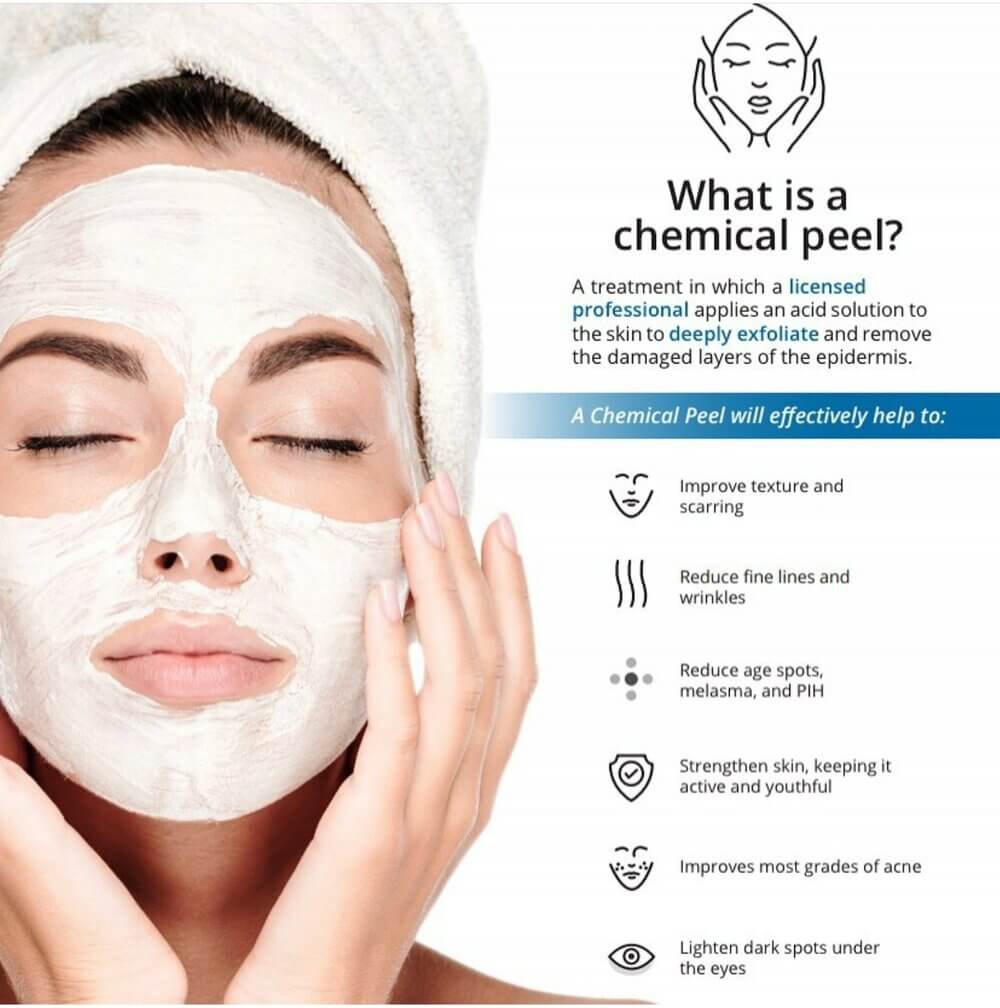


Chemical Peels
Another indication of ageing is dull, uneven, and patchy skin. Because the skin can regenerate quickly, new cells are brought to the surface and old ones are regularly removed, leaving healthy, young skin smooth and radiant. However, as we age, the skin's capacity to regenerate lessens, resulting in an accumulation of dead skin cells on top that makes the skin appear dull. Your skin may also appear lifeless, uneven, and dull as a result of various environmental factors like UV damage and lifestyle choices.
These are also the earliest early ageing symptoms, therefore you should address them to maintain your youthful beauty.
Chemical peels can be used to effectively cure dull skin and uneven skin tone. By removing the top layer of aged skin with a chemical solution, they enhance the appearance of ageing skin. It is typically replaced with new skin that is smoother and less wrinkled in appearance.

What Does Chemical Peeling Treat?
Chemical peeling techniques are typically carried out on the hands, neck, and face. Fair-skinned and light-haired folks make the best candidates for this surgery.
Fine Lines Around the Mouth & Under the Eyes:
Chemical peels are particularly successful at removing wrinkles and fine lines around the mouth and eyes. They can be applied as treatments for the skin's outer layer to smooth out fine wrinkles. Chemical peels are also useful for addressing and repairing harm to the skin's tone and texture.
Wrinkles:
The proper chemical peels must be applied to address wrinkles. The application of the chemical peel causes controlled damage to the skin's outer layer, exposing fresher, younger skin.
Mild Facial scarring:
Chemical peels can be used to remove damaged skin cells and lessen the appearance of ageing. By exfoliating the dead skin, they assist in enhancing the texture and health of your skin. Using chemical peels that contain betahydroxy acid (BHA) or alphahydroxy acid (AHA), the skin is gently exfoliated and washed (BHA).

How do Chemical Peels Work?
Your skin's look is improved by the chemical peel procedure. A chemical solution is administered to the skin during the procedure. The skin gradually peels off as a result of the blistering caused by the chemical solution. After the procedure, the regenerated skin is typically more supple and less wrinkled. The face, neck, and/or hands may be treated with a chemical peel.
The chemical peel technique is an outpatient one, therefore the patient does not need to stay overnight. The person performing the treatment will first clean your skin before applying one or more chemical solutions to small sections of your skin, such as salicylic acid, lactic acid, carbolic acid, etc. As a result, regulated wounds form, allowing new skin to grow in their place. The majority of patients feel a burning sensation for 5 to 10 minutes throughout the procedure. It is suggested to provide a cold compress to the treated region to reduce pain.
Before & After
Previous slide
Next slide

Schedule your appointment
Frequently asked questions
Chemical peeling agents resurface the skin by inducing a controlled wound and thus removing superficial layers of the skin. As a result, chemical peels promote the growth of a new healthy top skin layer and improve skin problems like hyperpigmentation, fine lines and wrinkles, uneven texture and skin impurities.
There are three different types of peel: superficial, medium and deep peels. These are categorised by the strength of the acid solution used in the peel and how deeply they penetrate the skin. Deeper peels penetrate the skin further and require greater recovery time. At Invivo Aesthetics, we only perform superficial peels, as these has minimum side effects and recovery time.
Procedures may vary dependent on the type of chemical peel chosen. Skin is prepped using a medical degreaser to ensure the treated area is free of any oils left on the skin. The chemical agent is then applied and typically remains on the skin for 3 to 5 minutes. Most patients feel a mild stinging which is temporary and usually subsides after a few minutes. Some peels are designed to self neutralize and may remain on your skin for 2-4 hours.
Peeling will generally start 48-72 hours after your treatment and can last 2-5 days. It is very important not to pick off peeling skin; peeling is minimal and easily controlled with moisturizer. Premature peeling of the skin will result in dry, cracked, raw skin that may develop into hyperpigmentation.
Exercise that produces a lot of heavy sweating should be avoided the day of the peel. You may resume all regular activities the next day.








